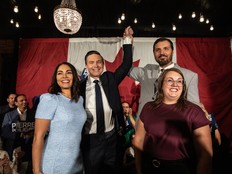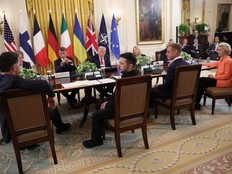An election like no other promises to damage Canada’s finances

Article content
Canada’s fiscal position is set to worsen as the country’s two leading political parties vie to win an election by promising tax cuts and measures to protect industries from U.S. President Donald Trump’s tariff barrage.
Canada projected a $42.2 billion deficit for this fiscal year, about 1.3% of the country’s gross domestic product. But the fiscal and borrowing picture is getting muddier, with campaign pledges tallying in the tens of billions of dollars each from Conservative Leader Pierre Poilievre and Mark Carney, the Liberal leader and prime minister.
The April 28 election has higher stakes than any Canadian vote in recent memory. Trump has threatened not only Canada’s economy but its sovereignty, repeatedly taunting it as a future 51st state. The global trade war he started risks plunging Canada into a recession, adding pressures to tax revenues and spurring more spending to help businesses and workers. Both parties have also promised to invest more in defence.
Canada, which is rated AAA by S&P Global, would join a global trend of greater borrowing as the U.S. pulls back from long-held economic and security relationships. Germany unlocked hundreds of billions of euros for defence and infrastructure, and other European nations are set to make similar moves. China is expected to unleash fiscal stimulus in response to Trump’s tariffs.
Carney and Poilievre have both talked about showing greater spending restraint than former Prime Minister Justin Trudeau, who nearly doubled the national debt during his time in power, mostly because of the Covid pandemic. But campaign promises and the trade war mean that “a more expansionary fiscal stance looks likely under almost any scenario,” according to Rebekah Young, an economist with Bank of Nova Scotia.
Poilievre has made tax cuts the centerpiece of his economic platform. His pledge to chop 2.25 percentage points off the tax rate for the lowest income bracket is likely to cost $12 billion to $14 billion annually, while a proposed deferral of capital gains taxes on Canadian investments would remove more than $10.5 billion in revenue over two fiscal years.
The Conservatives will release a costed platform to provide details of their fiscal plan, according to a spokesperson. The Conservative leader has said he would cut foreign aid, “corporate welfare,” consultants and public service jobs.
Carney wants to split the federal budget into two: an operating budget, which he says the government would balance in three years, and a capital spending budget, which would carry a deficit of about 1% of gross domestic product to fund projects that boost the country’s productive capacity. In the capital budget, “there’s a different kind of justification for making that type of investment,” Scotiabank’s Young said.
The Liberals’ proposed income tax cut is smaller than the Conservatives’ and Carney has spent much of his campaign rolling out spending ideas that fit with his Liberal leadership campaign slogan: “It’s time to build.” They include a $5 billion fund to accelerate projects at ports, railroads and airports to diversify Canada’s trade away from the U.S., and a government homebuilding entity that would provide $35 billion in financing to address the country’s housing supply shortage.
Carney has said he would balance the operating budget by slowing the growth of government spending, initially capping the size of the public service and deploying technology — including artificial intelligence — for efficiencies. The Liberals are promising to release fiscal projections before election day.
About four in five Canadians say they care or somewhat care about the size of the federal deficit, according to a recent poll of 1,054 Canadians by Nanos Research for Bloomberg. But demands for spending are building after Trump placed import taxes on Canadian autos, steel, aluminum and other goods, prompting the government to retaliate.
The chaotic shifts in Trump’s tariff policy have caused wild swings in markets since April 2. The president’s 90-day pause for many of the global tariffs last week may help Canada avoid a recession, but GDP growth is likely to slow to a crawl while retaliatory tariffs push core inflation above 3%, Stephen Brown, deputy chief North America economist with Capital Economics, said in a report.
The potential stagflation caused by a trade war is more likely to require a stronger fiscal response than a monetary one. Bank of Canada Governor Tiff Macklem has suggested he can’t cut rates deeply because of inflation risks, and economists and markets are leaning toward the central bank holding rates steady on Wednesday.
“I think a lot of the talk of balanced budgets is really something that’s just not realistic anytime soon,” said Randall Bartlett, deputy chief economist at Desjardins Group.
Both leaders have promised to use money raised from retaliatory tariffs to support businesses and workers who are affected by the trade war. But counting on tariff revenues is a risky bet due to changing and unstable import flows.
“At the end of the day, revenues are still going to be lower, expenses are going to be higher and you’re going to be running a bigger operating deficit,” Bartlett said.
Canada also faces unavoidable pressure to increase defence spending. The country has long failed to meet the North Atlantic Treaty Organization target of spending 2% of GDP on defence, and Trump has called for the benchmark to be raised as high as 5%. Carney has said a government led by him would hit 2% no later than 2030, while Poilievre promised to meet the target if the U.S. expands trade with Canada.
To be sure, Canada’s debt-to-GDP ratio, at about 42%, gives it some fiscal room. “Canada’s deficit compares favorably with other G-7 countries, leaving it flexibility to respond to current shocks,” Travis Shaw, senior vice-president at Morningstar DBRS, wrote in a report to investors.
— With assistance from Derek Wallbank.











Postmedia is committed to maintaining a lively but civil forum for discussion. Please keep comments relevant and respectful. Comments may take up to an hour to appear on the site. You will receive an email if there is a reply to your comment, an update to a thread you follow or if a user you follow comments. Visit our Community Guidelines for more information.